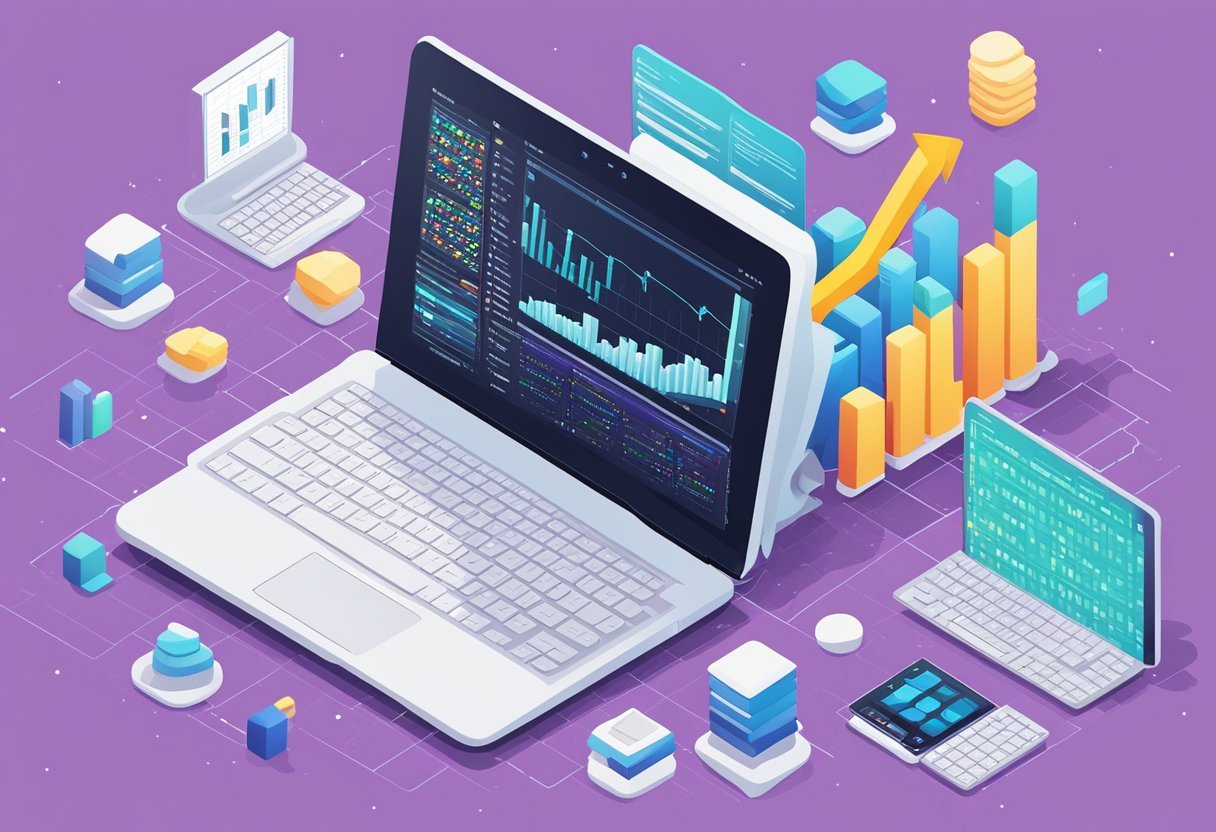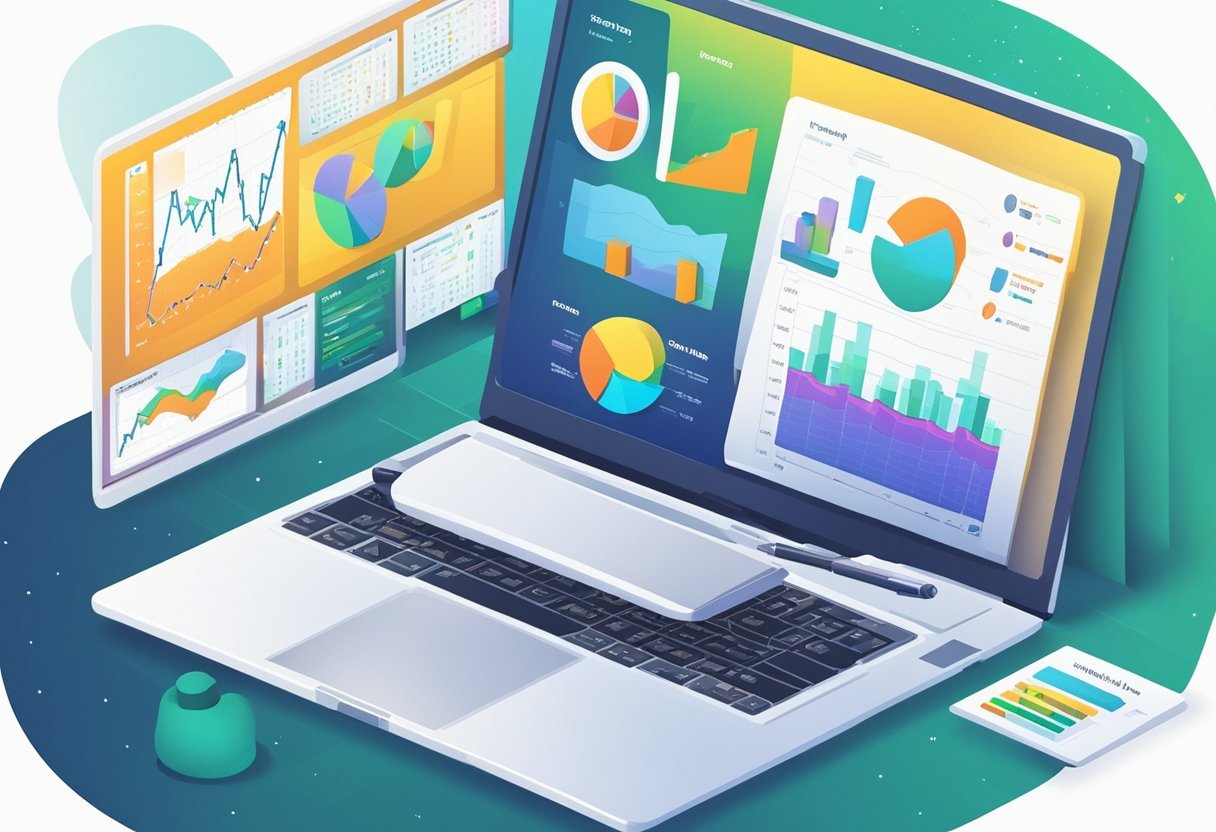Getting Started with Pandas
Beginning with Pandas involves setting up your Python environment and understanding key principles of this popular data analysis library.
This section will guide you through the installation process and introduce you to the foundational concepts critical for effective data manipulation and analysis.
Installation and Setup
To start using Pandas, one must first install Python if it is not already on the system.
Python can be downloaded from the official Python website. After installing Python, open a terminal or command prompt.
To install Pandas, use the following command:
pip install pandas
This will download and set up the Pandas library on your machine.
It’s also recommended to install Jupyter Notebook, an interactive tool that makes it easy to work with Python and Pandas. Use this command:
pip install jupyter
Once installed, launch Jupyter with:
jupyter notebook
This opens a notebook interface in the web browser, where you can write and execute Python code.
Having Pandas and Jupyter set up allows users to start exploring data science projects right away.
Pandas Fundamentals
Pandas is a powerful Python library for data management and analysis. The core components of Pandas are DataFrames and Series.
A DataFrame is a 2-dimensional labeled data structure, akin to a table in a database or Excel spreadsheet. A Series is a one-dimensional labeled array, like a column in a table.
To create a DataFrame, use:
import pandas as pd
data = {'Name': ['Alice', 'Bob'], 'Age': [25, 30]}
df = pd.DataFrame(data)
This snippet creates a simple DataFrame with names and ages.
Users can perform tasks such as filtering, grouping, and merging data. Mastery of these basics is essential for efficient data analysis and visualization using Pandas.
The library supports data cleaning, mutation, and aggregation, making it a favorite for those working with datasets in Python.
Understanding Data Structures

Data structures are fundamental in handling data with pandas. They help organize and manage data in a way that makes analysis straightforward and efficient.
Key structures include Series, DataFrames, and ndarrays.
Series and DataFrames
A Series is a one-dimensional array in pandas that holds data of a similar type. It’s similar to a list or array but with labeled indices. Labels make data retrieval more intuitive. For example, accessing data by label rather than by index number can simplify operations in various datasets.
A DataFrame is a two-dimensional, size-mutable, and heterogeneous tabular data structure. It consists of rows and columns, similar to a table in a database or a spreadsheet. DataFrames can hold different types of data across columns and are central to data manipulation in pandas.
Basic operations such as accessing, filtering, and summarizing data are streamlined with Series and DataFrames. They both allow for data alignment, handling of missing data, and integration with other libraries.
Working with Ndarrays
Ndarrays come from the NumPy library and represent N-dimensional data. They form the backbone for many operations in pandas.
While pandas adapts ndarrays into its Series and DataFrames, ndarrays themselves are ideal for numerical operations due to their performance efficiency.
These arrays are versatile, supporting various data types and operations like slicing, indexing, and mathematical transformations. Though not labeled like pandas structures, their speed and efficiency in handling large datasets make them useful in performing heavy computations before manipulating data in pandas.
Pandas smoothly integrates with these arrays, enabling the conversion of ndarrays into DataFrames with ease, enhancing data analysis capabilities by combining flexibility with efficiency.
DataFrames vs Series
While both Series and DataFrames are crucial in pandas, they suit different needs.
A Series is optimal for handling a single list of data, focusing on indexing and selection with labeled data. It is particularly useful when dealing with a single column or row from a DataFrame.
DataFrames, being two-dimensional, excel at handling structured tabular data, where rows and columns can vary in data types. This versatility supports complex data operations, including merging, joining, and reshaping.
The choice between using a DataFrame or Series depends on the dataset’s complexity and structure, with DataFrames providing more flexibility for detailed analysis of complex datasets.
Data Import/Export

Data import and export are key tasks in data science for moving data into and out of software like Pandas. This process involves reading data from various file formats and saving manipulated data back into files. Understanding these tasks is crucial for handling data efficiently.
Reading CSV/Excel/SQL/JSON
Pandas provides several functions to read data from different formats.
The read_csv function is commonly used for importing data from CSV files. With a single line of code, one can load a CSV file into a DataFrame, making it easy to start analyzing data.
For Excel files, Pandas offers read_excel, which supports reading multiple sheet formats. This can be especially handy for datasets with various segments on separate sheets.
Data from SQL databases can be imported using SQL queries. The function read_sql allows users to read from SQL databases directly into Pandas, facilitating smooth data analysis without needing to manually export queries.
Similarly, JSON data can be loaded using the read_json function, which is helpful for web-based data or APIs that return JSON objects.
Exporting Data to CSV/JSON
Exporting data is as straightforward as importing it.
The to_csv function enables users to save DataFrames back into CSV format. Options include specifying the delimiter, handling headers, and more, giving flexibility in the export process.
For JSON files, to_json allows conversion of DataFrames into JSON format. This is popular for sharing data across web applications. JSON files are lightweight, making them ideal for long-term storage or data transmission on the web.
These functions ensure data remains accessible and shareable after processing, making it easier for further analysis or reporting.
Data Cleaning Techniques

Data cleaning is a vital process in any data science workflow. It ensures that data is accurate, consistent, and free from errors. Key techniques include handling missing values, transforming data, and filtering rows and columns to prepare datasets for analysis.
Handling Missing Values
Missing values can negatively affect data analysis. You must first identify missing data, which can appear as blanks, “NaN” in Pandas, or “null” values.
Filling these gaps is crucial, and one method is using the Pandas fillna() function to replace missing data with specific values, such as the mean or median.
Dropping rows or columns containing numerous missing values is sometimes necessary. This can be done using dropna(). It’s important to consider the impact of these actions on the dataset’s integrity.
Another approach is to use interpolation, which estimates missing values based on available data points.
Data Transformation
Data transformation includes modifying data to improve its format or structure, which enhances analysis.
One such transformation is scaling, which adjusts data ranges. This is often done through normalization or standardization. The Pandas library offers functions like apply() and map() to help transform data efficiently.
You can also use log transformation to manage skewness in data distributions.
Converting categorical variables into numerical values using techniques like one-hot encoding is also essential.
Python libraries such as Pandas and SciKit-learn provide these capabilities, enabling data scientists to transform data effectively.
Filtering Rows and Columns
Filtering is essential for focusing analysis on relevant data segments. Boolean indexing is a powerful tool for this purpose.
It allows you to select data based on conditions, such as filtering rows where a column value exceeds a threshold. In Pandas, this can be achieved using expressions like df[df['column'] > value].
Column filtering involves selecting necessary features and discarding irrelevant ones, which helps reduce noise in the data.
Methods like loc[] and iloc[] in Pandas provide flexible ways to filter both rows and columns. Applying filters can significantly enhance data quality and analysis outcomes without altering the core dataset.
Data Manipulation and Transformation
Data manipulation and transformation are key processes in data science, often involving techniques like aggregating data, creating pivot tables, and performing vectorized operations. These methods help in refining raw data into a structured format that is easier to analyze and visualize.
Aggregating Data
Aggregating data is vital for summarizing information. By using functions like sum(), mean(), and count(), analysts can condense extensive datasets into meaningful summaries. This process helps in understanding trends and making data manageable.
For instance, calculating the average sales per quarter offers insights into business performance.
In Pandas, aggregation functions are applied to dataframes or series, allowing you to specify either rows or columns for the calculation. Such flexibility enhances the ability to generate custom insights.
An example might be calculating the total revenue for different regions using Pandas. This supports decisions by making trends more visible.
Pivot Tables and GroupBy
Pivot tables and the groupby function are essential tools for reorganizing data.
Pivot tables, similar to those in spreadsheet software, allow data to be summarized, compared, and analyzed across different dimensions. This is extremely helpful for identifying patterns.
The groupby function in Pandas is versatile, grouping data based on one or more columns. It enables detailed analysis by allowing operations like summation, averaging, and counting within each group.
For example, sales data can be grouped by product category to determine which category contributes most to revenue, enhancing understanding of market dynamics.
Vectorized Operations
Vectorized operations enhance performance by applying computations directly to array or table structures rather than iterating through elements. This approach is efficient for large datasets as it leverages low-level optimizations. The result is faster processing speeds and reduced complexity.
In Pandas, vectorization allows operations like element-wise addition, subtraction, or logical operations on dataframes.
Such operations are crucial for data transformation, enabling swift handling of datasets without explicit loops. For instance, calculating price increases across a large dataset can be achieved in a single step, allowing quicker insights into price trends.
Exploratory Data Analysis (EDA)
Exploratory Data Analysis (EDA) is a crucial step in data science. It helps data scientists and business analysts uncover patterns, spot anomalies, and test assumptions. This process involves various techniques, focusing on summary statistics and correlation analysis to draw meaningful conclusions from data.
Summary Statistics
Summary statistics provide a quick overview of data through key figures. These include mean, median, mode, standard deviation, and range.
By calculating these metrics, data professionals can get a sense of the central tendency and variability in the dataset. For instance, the mean shows the average value, while the standard deviation indicates how much data varies from the mean.
These statistics are essential in identifying outliers or unusual data points that might skew the results.
Using tools like Pandas in Python, such calculations are straightforward. Data scientists often rely on summary statistics as a foundational step in EDA, allowing them to make informed decisions about data preprocessing and analysis. This aids in ensuring data quality and reliability before diving into complex modeling.
Correlation and Statistical Analysis
Correlation and statistical analysis focus on relationships between variables.
Understanding these connections can highlight how one variable may predict or affect another.
Correlation coefficients, like Pearson’s or Spearman’s, measure the strength and direction of these relationships. A correlation near +1 or -1 indicates a strong relationship, while a value close to 0 suggests no correlation.
Statistical analysis goes beyond correlation by testing hypotheses or assessing the significance of relationships.
Techniques such as regression analysis help in predicting outcomes and understanding complex interactions within data.
These analyses are crucial for data scientists and business analysts to inform strategic decisions and guide further exploration. Leveraging Python libraries like SciPy and Matplotlib simplifies integrating these analyses within the data workflow.
Data Visualization
Data visualization is a crucial part of analyzing data with Pandas.
Tools like Matplotlib and Seaborn help create various visual representations.
These tools can be used for plotting different types of graphs, including bar plots and histograms, which are essential for understanding data distributions and trends.
Plotting with Matplotlib and Seaborn
Matplotlib is a popular library used for plotting graphs in Python.
It provides a wide range of plotting options from simple line graphs to complex 3D plots.
It’s known for its flexibility and comprehensive customization options.
Users can adjust everything from colors and line styles to axis labels and gridlines, making it a versatile tool for detailed visualization work.
Seaborn is built on top of Matplotlib, offering a higher-level interface for creating visually appealing and informative statistical graphics.
It simplifies tasks like drawing attractive plots in a few lines of code.
Seaborn includes built-in themes and color palettes, which make it easier to create professional-looking visualizations without extensive configuration.
Features like multi-plot grids and specialized plots for categorical data add depth to visualization capabilities.
Creating Bar Plots, Histograms, and More
Bar plots are essential for comparing categorical data.
They represent data with rectangular bars, the lengths of which are proportional to the values they represent.
Bar plots can be created efficiently using both Matplotlib and Seaborn, with customization options for colors, orientation, and grouped or stacked bars.
Histograms are crucial for visualizing the distribution of numerical data.
They display data using bins to show frequency counts of data intervals.
These plots help in understanding data spread and identifying patterns like skewness or the presence of outliers.
Both Matplotlib and Seaborn offer functions to create detailed histograms, making them invaluable for statistical analysis and initial data exploration.
Machine Learning with Pandas
Machine learning with Pandas involves preparing data, selecting features, and performing various analyses like regression.
This process often uses tools like scikit-learn for efficient data handling and model building.
Feature Selection
Feature selection is a vital part of using Pandas for machine learning.
It involves selecting the most relevant data features for a model. This step improves accuracy and reduces computation time.
Pandas can be used to manage and preprocess data, making it easier to identify important variables.
Using Pandas in combination with scikit-learn, users can automate feature selection with methods like recursive feature elimination or by applying feature importance scores.
These methods help in narrowing down the dataset to include only the features that significantly contribute to the model’s predictions.
Regression Analysis
Regression analysis with Pandas helps in understanding relationships between variables.
It is widely used to make predictions and model trends within datasets.
Tools like scikit-learn provide functions for different regression models, from simple linear regression to more complex methods.
Data must be clean and well-prepared in Pandas before applying regression models.
Pandas facilitates data processing by providing functions for handling missing data, normalizing values, and structured data formatting.
Effective data visualization can also be a part of this analysis, allowing users to visually interpret model outputs and assess the fit of regression lines.
This integration of Pandas and scikit-learn enables efficient workflows for predictive modeling.
Time-Series Analysis
Time-series analysis involves studying datasets where observations are recorded at specific time intervals.
It is essential for spotting trends, seasonal patterns, and cyclical changes, making it crucial in fields like finance, economics, and environmental studies.
Working with Time Series Data
Time series data is characterized by its time-ordered nature. Analysts often start by cleaning and preparing datasets to handle missing values and outliers. This preparation ensures the reliability of the analysis.
A common technique in time-series analysis is decomposition, which separates data into trend, seasonal, and residual components. This helps in understanding underlying patterns.
Forecasting future values based on historical data is an essential task in this context.
Utilizing libraries like Pandas can streamline processes such as data manipulation and visualization, which are key for effective analysis.
Resources like the Time Series Analysis with Python Cookbook offer practical recipes for handling such data efficiently.
Advanced Topics in Pandas

When working with large datasets, it’s crucial to focus on performance tuning and memory optimization in Pandas. These practices improve task efficiency and reduce resource consumption, which is essential for handling big data effectively.
Performance Tuning
Optimizing performance in Pandas can be achieved through various methods.
One key approach is vectorization, which involves using Pandas functions that operate on entire arrays instead of iterating through elements. This makes operations significantly faster.
For example, using apply() can be slower compared to vectorized operations like mean() or sum().
Another method is using Cython or Numba for speeding up complex Python functions. This involves translating Python code to C for faster execution.
Additionally, choosing efficient data types for columns, such as category for string data that takes on a limited number of unique values, can enhance performance by reducing both processing time and memory usage.
Memory Optimization
Memory optimization ensures that processes run smoothly, even with limited resources.
One important strategy is to reduce memory usage by downcasting numeric types. For instance, converting float64 to float32 where precision is not critical can cut memory usage significantly.
Using chunksize in read functions helps manage memory by processing data in smaller portions. This is especially useful for reading large files without loading everything into memory at once.
Pandas also offers tools to parse only necessary data. For example, specifying columns while loading a dataset with usecols minimizes memory consumption by excluding irrelevant data.
Furthermore, converting data to more efficient formats, like storing DataFrames in Parquet files, can improve both memory usage and performance when dealing with big data and even when data is stored in HTML formats.
Applying Pandas in Real-world Projects
Using Pandas in real-world projects helps data scientists turn raw data into valuable insights.
Guided projects allow learners to apply skills practically on datasets like the Ebay Car Sales Data, showcasing how data analysis is executed in authentic scenarios.
Guided Project: Ebay Car Sales Data
In the Ebay Car Sales Data project, participants learn key data science skills by working with a dataset of used cars. This guided project provides a practical experience in cleaning, manipulating, and analyzing data using Pandas.
Learners focus on transforming messy data into clean, structured formats. This involves handling missing values, creating new variables, and extracting insights using various Pandas functionalities.
Such hands-on exercises are crucial for developing a strong understanding of data workflows, making it easier to tackle similar tasks in professional settings.
Case Studies and Scenarios
Real-world case studies often highlight how Pandas can streamline data workflows.
These scenarios show practical applications, such as using Pandas to analyze market trends, optimize operations, or improve decision-making processes.
Data scientists benefit from these experiences by understanding the significance of efficient data handling and processing. They learn how to create meaningful data visualizations and reports, which are essential for communicating findings and influencing business strategies.
Such projects help bridge the gap between theoretical knowledge and practical application.
They empower individuals to become proficient in data-driven decision-making, a critical skill in modern data science environments. By engaging with these examples, learners gain a clearer perspective on the role of data manipulation and analysis in everyday tasks.
Frequently Asked Questions

This section covers key aspects of using Pandas for data science. It includes data manipulation, starting with data analysis, performing common cleaning tasks, handling missing values, managing datasets, and visualizing data.
What are the essential features of Pandas for data manipulation in data science?
Pandas offers data structures like Series and DataFrame that make data manipulation easy and efficient.
It allows filtering, sorting, and grouping data effortlessly. Functions like loc, iloc, and groupby are crucial for slicing data and analyzing it based on different criteria.
How can one start with data analysis using the Pandas library?
To begin data analysis with Pandas, one should first install the library using pip install pandas.
After installation, importing Pandas in a Python script is essential.
Using functions like read_csv or read_excel, data can be imported into a DataFrame for exploration and manipulation.
What are some common data cleaning tasks in Pandas and how are they performed?
Common data cleaning tasks include removing duplicates, renaming columns, and converting data types.
Pandas provides functions like drop_duplicates for duplicate removal and rename for renaming columns.
Converting data types can be done using astype.
How do you handle missing values in a dataset with Pandas?
Handling missing values involves identifying and dealing with them using Pandas methods.
The isnull function helps detect missing values, while fillna allows filling them with specific values or methods like forward fill.
The dropna function is used to remove any rows or columns with missing data.
Can you explain how to merge and concatenate different datasets using Pandas?
Pandas enables dataset merging using merge for joining DataFrames based on keys, similar to SQL joins.
Concatenation is achieved with concat, which combines DataFrames either vertically or horizontally.
These methods are vital for assembling large datasets from various sources.
What is the best way to visualize data directly from a Pandas DataFrame?
Visualizing data from a Pandas DataFrame can be easily done using the library’s integration with Matplotlib.
The plot function in Pandas generates basic plots like line graphs or histograms directly from a DataFrame.
For more advanced visualizations, using Pandas with libraries like Seaborn is effective.
